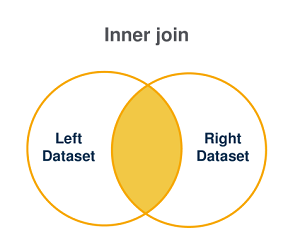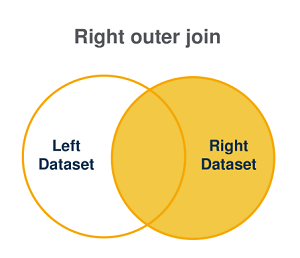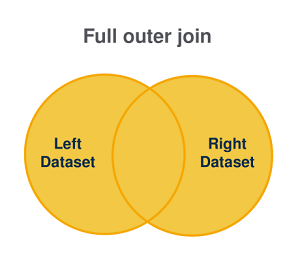Additional information about join operations
The Join processor allows you to apply four different types of join operations to your hierarchical data.
Inner join
This type of join operation is used to:
- match the values that are common between two datasets.
- create a result set with all the pairs that match.

The result set is determined as follows:
| If the join statement is satisfied (dataset L matches dataset R) | If the join statement is not satisfied |
|---|---|
| All matching records are combined and returned in the result set | Non-matching records are ignored |
Left outer join
This type of join operation is used to:
- match the values that are common between two datasets AND retain all the values that exists in the left dataset
- create a result set combining these records

The result set is determined as follows:
| If the join statement is satisfied (everything that is in dataset L + matches in the two datasets) | If the join statement is not satisfied |
|---|---|
| All records in the left dataset as well as the matching records between dataset left and dataset right are combined and returned in the result set | Non-matching records are ignored |
Right outer join
This type of join operation is used to:
- match the values that are common between two datasets AND retain all the values that exists in the right dataset.
- create a result set combining these records.

The result set is determined as follows:
| If the join statement is satisfied (everything that is in dataset L and R + matches in the two datasets) | If the join statement is not satisfied |
|---|---|
| All records in the left dataset as well as the matching records between dataset left and dataset right are combined and returned in the result set | Non-matching records are ignored |
Full outer join
This type of join operation is used to:
- retain all the values that match in the left and right datasets.
- create a result set combining these records.

The result set is determined as follows:
| If the join statement is satisfied (everything that is in dataset L + matches in the two datasets) | If the join statement is not satisfied |
|---|---|
| All records in the left dataset as well as the matching records between dataset left and dataset right are combined and returned in the result set | Non-matching records will be listed in the result set as NULL |
Did this page help you?
If you find any issues with this page or its content – a typo, a missing step, or a technical error – let us know how we can improve!
